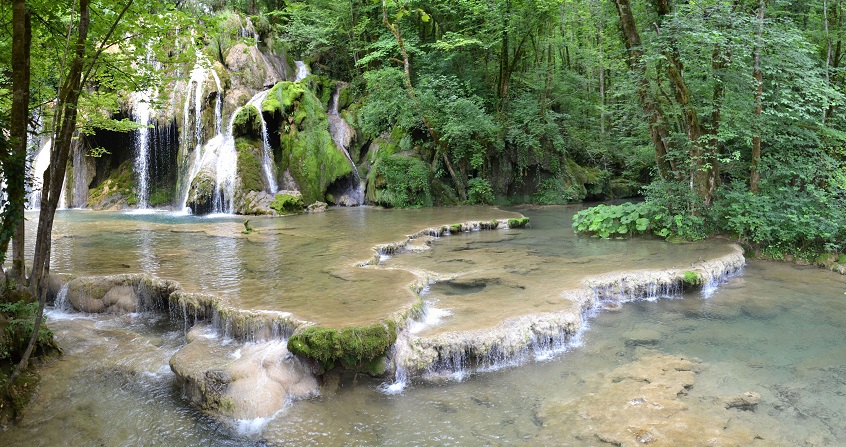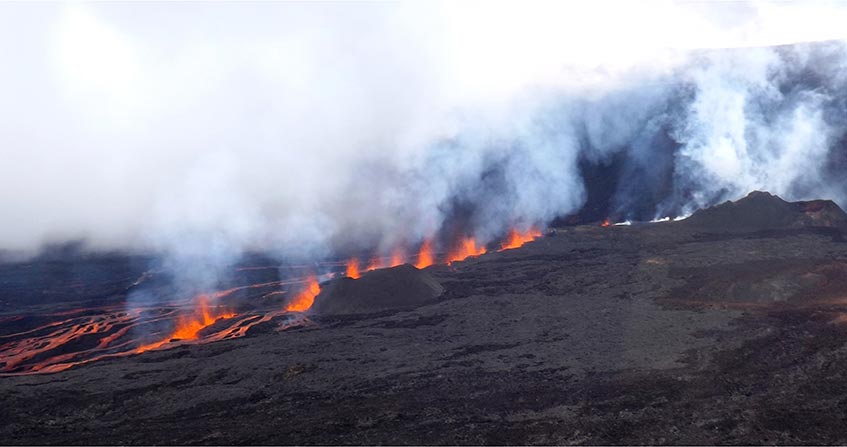Massive extinctions in geological time
PDF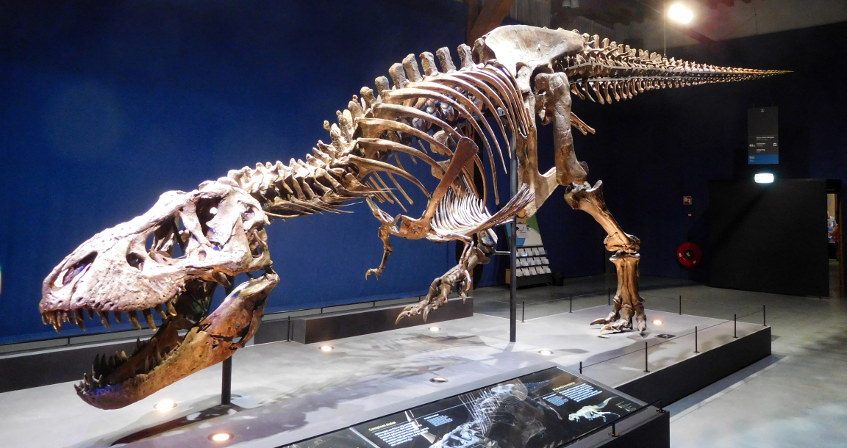
At least five times in the past, a large number of species have disappeared in a short period of time [1]. The study of these five major extinctions brings paleontologists, climatologists, geochemists and ecologists closer together and provides comparative references for ongoing ecological changes. All different, each extinction has profoundly reshaped biological diversity, changed the course of living history… and our scientific conceptions.
All species die out sooner or later. Paleontologists estimate that, on average, the life span of a paleontological species does not exceed a few million years (and sometimes much less). The “normal” disappearance of a species can have various causes: the morphology of a population can change sufficiently for paleontologists to decide to defining a new species; a population can split into one or more others which, by diverging genetically, will separate sufficiently to constitute distinct species; ecological competition between species can lead to the ecological exclusion of one of them, etc. Extinction is therefore a normal process in the history of life.
But fossil records, studied since the early 19th century, suggested very early that living communities have undergone major changes during Earth history, during which many forms seem to have disappeared simultaneously, while others have appeared afterwards. These upheavals (at least apparent) are at the basis of the major divisions of the geological time scale.
1. Mass extinctions: an old idea, rejected and rediscovered
1.1. Cuvier’s “Globe Revolutions” against Lyell’s theory of “Causes now in operation”
“There is therefore nothing in the known facts to support in the least the view that the new genera I have discovered or established among the fossils, nor those that have been discovered or established by other naturalists […] may have been the strains of some of the animals of today […]” [2]
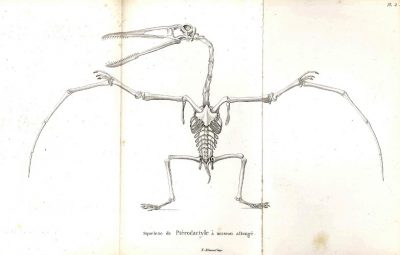
With the emergence of the theory of evolution, formalized by Charles Darwin (see Focus Darwin) in 1859 and consolidated in 1942 with the “synthetic theory of evolution” – which finally reconciled the progress of population biology with that of genetics – the idea that cataclysmic events could suddenly and randomly transform biological communities was rejected:
- On the one hand, according to the position defended by geologist Charles Lyell [3] and Darwin, geological phenomena, violent or not, observable today (erosion, absence of deposits, volcanism, earthquakes, sea level change…) were sufficient to explain the ancient events recorded in rocks [4];
- On the other hand, according to Darwin, biological evolution, the adaptation of populations to their environments, was a slow and continuous process.
Cuvier’s “catastrophism” was therefore abandoned in favour of Lyell’s “actualism” (Charles Lyell’s theory of “causes now in operation” is often referred to as the “principle of actualism” or “uniformitarianism”, even if uniformitarianism was first formulated by geologist James Hutton, 1726-1797). The idea of a biological crisis was thus banished from the scientific discourse of the 1950s and 1980s.
1.2. Speed and extent of disappearances, key markers of a crisis
Nevertheless, changes in fauna and flora were well documented in fossil records, and provided landmarks for cutting out sediments and constructing the geological time scale (the chronostratigraphic scale). But there were relatively slow changes, which could be explained by changes in sea level and plate tectonic movements.
Indeed, the majority of fossil species are marine organisms living in the shallow seas of the continental margins (the continental shelf). Sea level variations modify the area of these submerged edges (wider in periods of high sea level, more restricted in the opposite case), and therefore the quantity of species they can support. This surface also decreases when the continents come together in a supercontinent, as it was the case in Permian, 300 million years ago. On the contrary, it increases when the continental blocks diverge and separate.
It was when the rocks could be dated and assigned numerical ages (by radiochronology [5]) that the relative brevity of some of these episodes, and the disappearance of a large number of species in relatively short time intervals, could be demonstrated. At the same time, some paleontologists made an effort to identify all known marine fossils and to quantitatively assess paleo-biodiversity and its fluctuations (See Focus The species for the palaeontologist).
2. The massive extinctions of the past
2.1. Paleo-biodiversity is not biodiversity
Biodiversity (see What is biodiversity?) is a concept forged by and for biologists and ecologists; relevant to describe the current biosphere with modern technical means, including genetic analysis. It is not directly transferable to fossils [6]. Only morphology is accessible to the paleontologist, and it is often deformed or incomplete. The researcher can therefore only describe morpho-species (See Focus The species for the paleontologist), and the quantities of fossil species counted cannot be directly compared to those recorded in the current biosphere.
The American researcher John J. Sepkoski (1948-1999) devoted most of his career to identifying marine invertebrate fossils described in the literature and preserved in museum and university collections around the world. This huge database, with more than 31,000 genera [7], and the paleo-marine biodiversity curve derived from it, have become references. Other researchers, such as the British M. J. Benton, began similar collections for vertebrates and continental organisms. Since the 2000s, a collective effort to identify fossils, using recent collaborative computing, standardized descriptions and modern statistical analysis tools, has enabled paleontologists to build a new database, the Paleobiology Database [8].
2.2. Five crisis in fossiliferous times
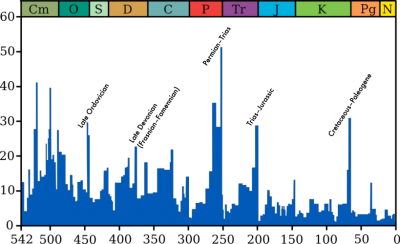
Table 1. The “five major” crisis of fossiliferous times (Adapted from Barnosky et al. [12]).
3. Explanations for mass extinctions
3.1. Cataclysmic volcanism, a systematic cause?
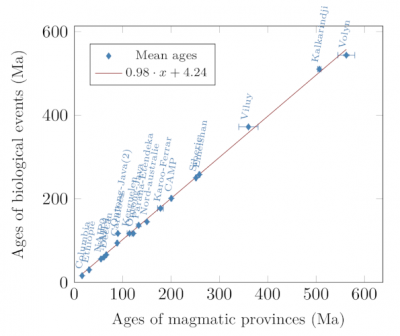
Is this volcanism the cause, or one of the causes, of extinctions? By which mechanisms could it have affected the biosphere? These questions have fuelled research on the effects of volcanoes. The 1991 Pinatubo eruption made it possible to monitor by satellite the fate of aerosols and gases projected at high altitude by this type of explosive volcano located at low latitudes. It was also possible to observe climate changes in the years that followed. These observations have inspired interpretations of other episodes of climate change that have occurred in historical times [16].
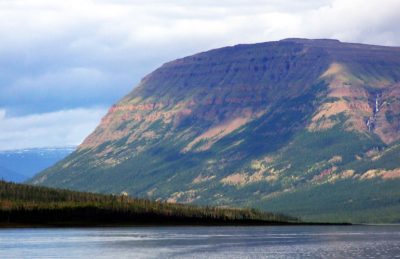
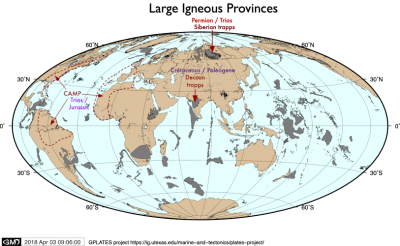
Such an event is therefore disproportionate compared to the explosion of a single Indonesian volcano. Its consequences have probably been unparalleled with what has been observed so far. Paleo-climatologists therefore try to imagine these effects, model them and look for potential traces. Figure 6 summarizes this scenario, distinguishing between the products probably emitted by volcanism and the direct and indirect pathways through which these emissions could lead to the observed result, a massive disappearance of organisms, both marine and continental. [18]
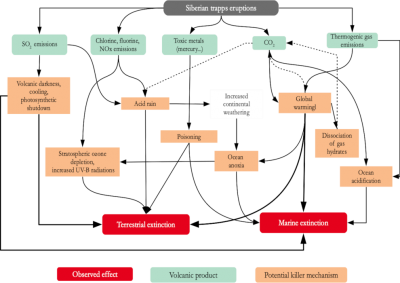
3.2. The Cretaceous-Paleogene crisis and the impact of a meteorite
The crisis at the end of the Cretaceous, 66 million years ago, was the one that saw the disappearance of dinosaurs (see Introductory Figure) [21], with the exception of birds that were part of it and had appeared a hundred million years earlier. Many other organisms disappear during this episode, including other reptiles (flying pterosaurs, marine mosasaurs…), many microorganisms (foraminifera), but also bird and mammal species! A volcanic cause is also considered here, since this period corresponds to the eruption of the Deccan traps in India (see Figure 5). However, in this particular case, several clues detected in the sediments deposited during this transition from the Cretaceous period to the next, the Paleogen, led to another hypothesis in the early 1980s: the impact of a relatively large asteroid (See Focus The Cretaceous-Paleogene crisis).
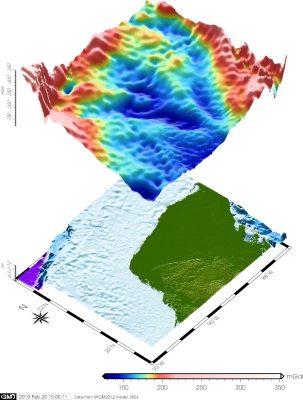
In the early 1990s, a meteorite impact site was identified by gravity measurements in the northeast of the Yucatan Peninsula in South America, in Chicxulub Province (Figure 7) [22]. Currently very flat, the edge of the Yucatan Peninsula has a roughly circular mass deficit in its subsoil of about 200 km in diameter (Figure 7, top part). This gravimetric anomaly corresponds to a decrease in land density compared to neighbouring regions. It is explained by an intense fracturing of the rocks hidden under the more recent, intact deposits. Drilling in this area has indeed recovered volcanic glasses and breccias, i.e. melted or crushed rocks, which the study has shown to have suffered an intense shock. In the absence of volcanism on this peninsula, the most plausible explanation for these observations is the impact of a meteor, whose size is estimated at about ten kilometres. The age of the affected lands and the distribution of impact products in the rest of the world suggest that this crater corresponds to the impact of the end of the Cretaceous (66 million years ago), although some debates remain.
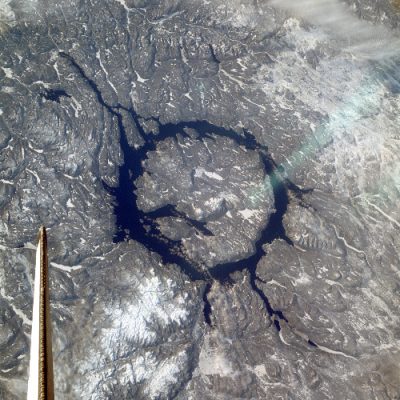
3.3. Extinctions caused by the evolution of life?
The meteorite cause of the extinction of the late Cretaceous appears to be an exception; however, the other major crisis are of comparable or even more intense importance. Perhaps volcanism then had more effects, in tectonic and ecological contexts different from those of the Cretaceous. Or other factors, climatic or biological, have been added.
This idea is put forward for two of the crisis of the Paleozoic era: the end of the Ordovician and the end of the Devonian (see Table 1). In both cases, extinctions concern marine organisms, while continents are just beginning to be colonized by plants (in the Ordovician) or forests are spreading there (in the Devonian). The colonization of the land, by organisms more complex than the microorganisms certainly already present, is likely to have disrupted the very functioning of the Earth’s surface envelopes.
Thus, experiments suggest that even very simple plants (mosses and lichens) promote the alteration of the rocks on which they settle and release the elements they contain into the runoff water. Conversely, vegetation reduces mechanical erosion (particle disintegration) of rocks. Rivers then bring more dissolved elements and less sediment to the sea. The implantation of plants therefore modifies the relative shares of chemical dissolution and physical disintegration of rocks: rivers thus bring less particles to the sea, but more dissolved elements.
This new operation could have encouraged the proliferation of marine microorganisms which, by consuming the oxygen dissolved in surface waters, would have deprived organisms living on the bottoms of the continental margins, causing some of them to disappear. By modifying carbon exchanges between air, water, the biosphere and soil (see A carbon cycle disrupted by human activities), these transformations may also have influenced climate (for example, by reducing atmospheric CO2 levels, promoting climate cooling; the end of the Ordovician is indeed marked by the development of an ice cap at the South Pole). (Read, to complete, The first terrestrial ecosystems and The Biosphere, a major geological player).
4. Past extinctions, current extinction: are they comparable?
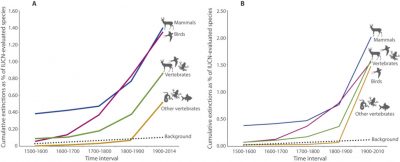
While this term “sixth extinction” is intended to highlight the extent of the phenomenon and its catastrophic nature, it is also misleading since it suggests that this disappearance of species (and more broadly this degradation of ecosystems) is comparable to previous ones.
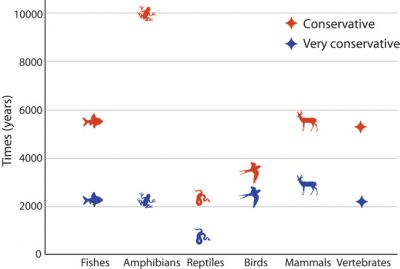
Only the meteorite impact of the Cretaceous period could have had such brutal effects. But the current case is also exceptional in that it is due to processes that we can study, understand, model and act on, unlike previous crisis, which are inevitable and unpredictable.
5. Messages to remember
- The existence of past biological crisis has once again become a subject of reflection and an active research topic since the discovery of chemical traces of a large-scale meteorite impact at the end of the Cretaceous period, 66 million years ago.
- All the fossils listed around the world make it possible to estimate fluctuations in past biological diversity and ecosystem disturbances. These studies show many episodes of declining diversity over the past 541 million years, and particularly five major episodes of biological community disruption, affecting many groups of organisms, including groups then flourishing.
- Their causes are probably always plural, with perhaps, in each case, the intervention of an intense volcanic episode, linked to the arrival on the surface of a large plume of deep material.
- The latest crisis, that of the Cretaceous-Tertiary boundary, is most likely related, in addition to the Deccan volcanism in India, to the impact of a large meteorite, which could correspond to the crater identified at Chicxulub, Mexico.
- These five “great extinctions” have each modified the evolutionary history of life, making certain groups disappear and encouraging the diversification of others.
- The study of these events makes it possible to study how ecosystems have been affected by these unusual phenomena, and to understand the complexity of interactions between biological communities and their geological environment. These past extinctions provide reference points for understanding changes in current ecosystems and measuring the extent and speed of disturbances due to human activities.
References and notes
Cover image. Trix, Tyrannosaurus fossil (see reference [20]). [Source: Photo By Rique (CC BY-SA 4.0), from Wikimedia Commons]
[1] For geology, “short” means a few million years at most. That is, a duration that may only be represented in the field by a boundary between two layers of rock.
[2] Cuvier G. (1840) Discours sur les révolutions de la surface du Globe, 8e édition, Paris, H. Cousin.
[3] Charles Lyell (1809-1882), British geologist, close friend of Darwin. He is the author of the Principles of Geology published from 1830 to 1833 and subtitled “being an inquiry how far the former changes of the earth’s surface are referable to causes now in operation“..
[4] A sudden transition between fossil species in two successive layers could be explained, for example, by a temporary interruption of deposition at this location.
[5] Radiochronology refers to all dating techniques based on the decay of certain radioactive isotopes of “parent” chemical elements, giving isotopes of another “son” element. Since the decay rate of the parent isotope is only a function of the amount of the parent isotope, measurements of the concentrations of the parent isotope or son isotope in a rock or crystal of an appropriate mineral provide the time elapsed since that object (the rock or mineral) incorporated the parent isotope, which has slowly disintegrated. The best known of these techniques is 14C (“father” element giving nitrogen 14 “sons”), or radiocarbon, mainly used in archaeology. Geologists use other father-son pairs, such as rubidium 87 – strontium 87, potassium 40 – argon 40, uranium 238 – lead 207, etc.
[6] With a few exceptions, in the case of relatively recent fossils (frozen mammoths from Siberian permafrost, teeth and bones of neanderthals or archaic Homo sapiens…) in which some molecules (DNA or proteins) are still recoverable and identifiable.
[7] Since fossil species are difficult to identify and differentiate with certainty, it is easier to count the higher levels of taxonomy, genera (e.g. lion, tiger and leopard) or families (e.g. Felidae family).
[8] https://paleobiodb.org/#/
[9] Rohde R.A. & Muller R.A. (2005) Cycles in fossil diversity. Nature 434, 208-210.
[10] These are the “Big Five”, the five major crisis of Anglo-Saxon literature.
[11] The Cambrian and Ordovician extinction peaks (between 542 and 450 million years ago in Figure 2) could be explained by the ecological upheavals produced by the diversification of organisms during this period, during which the main groups of animals appear and transform their environment, building new networks of interactions and new ecological niches.
[12] Barnosky A.D. et al. (2011) Has the Earth’s sixth mass extinction already arrived? Nature 471, 51-57
[13] The Cretaceous-Paleogene crisis also corresponds to the passage from the Mesozoic to the Cenozoic (the “recent life”).
[14] Courtillot V. & Reindeer P. (2003) On the age of flood basalt events. Comptes Rendus Géoscience 335, p. 113-140. https://www.sciencedirect.com/science/article/pii/S1631071303000063
[15] Bond D.P.G. & Wignall P.B. (2014) Large igneous provinces and mass extinctions: An update. Geological Society of America Special Papers 505: 29-55. http://specialpapers.gsapubs.org/content/505/29.abstract
[16] For example, the unusually harsh and disturbed European climate of the 1816-1820s, now attributed to the explosion of the Tambora volcano in Indonesia in April 1815. Henrik H.
[17] Jerram Dougal A., Svensen, Planke Sverre, Polozov Alexander G., Torsvik, Trond H. (2016) The onset of flood volcanism in the north-western part of the Siberian Traps: Explosive volcanism versus effusive lava flows, Palaeogeography, Palaeoclimatology, Palaeoecology, Volume 441, Part 1, , Pages 38-50, ISSN 0031-0182, https://doi.org/10.1016/j.palaeo.2015.04.022.
[18] Bond D.P.G. & Grasby S.E. (2017) On the causes of mass extinctions. Palaeogeography, Palaeoclimatology, Palaeoecology 478, 3-29.
[19] This supercontinent was named Pangea (“all the earth” in Greek) by meteorologist Alfred Wegener (1880-1930) who had proposed its existence in 1912. He explained it by his hypothesis of “continental drift”, whose arguments were then incorporated into the current theory of plate tectonics, accepted since the late 1960s.
[20] The over-rection of a mountain represents a reduction in the available surface area and that high-altitude regions generally support fewer species than plains.
[21] The Tyranosaurus Trix (cover photo) was discovered in 2013 in Montana, USA, by a team of paleontologists from the Naturalis Biodiversity Center in Leiden, the Netherlands. It is the oldest known Tyrannosaurus specimen, a female over thirty years of age, and considered to be the third most complete Tyrannosaurus found, with between 75% and 80% of its bone volume recovered.
[22] Alan R. Hildebrand, Glen T. Penfield et al (1991) Chicxulub Crater: A possible Cretaceous/Tertiary boundary impact crater on the Yucatán Peninsula, Mexico. Geology v. 19, pp. 867-871.
[23] Recent analyses -Field D.J. et al (2018) Early Evolution of Modern Birds Structured by Global Forest Collapse at the End-Cretaceous Mass Extinction. Current Biology 28, p1825-1831.e2- suggest that these fires would have caused the disappearance of most of the many bird species that existed in North America at the time. A new diversification of birds would have taken place after this episode, from a few surviving groups living on the ground.
The Encyclopedia of the Environment by the Association des Encyclopédies de l'Environnement et de l'Énergie (www.a3e.fr), contractually linked to the University of Grenoble Alpes and Grenoble INP, and sponsored by the French Academy of Sciences.
To cite this article: LANGLOIS Cyril (April 2, 2019), Massive extinctions in geological time, Encyclopedia of the Environment, Accessed April 20, 2024 [online ISSN 2555-0950] url : https://www.encyclopedie-environnement.org/en/life/massive-extinctions-in-geological-time/.
The articles in the Encyclopedia of the Environment are made available under the terms of the Creative Commons BY-NC-SA license, which authorizes reproduction subject to: citing the source, not making commercial use of them, sharing identical initial conditions, reproducing at each reuse or distribution the mention of this Creative Commons BY-NC-SA license.






